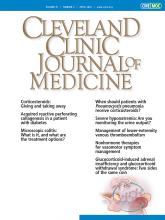
In Dickensian terms, corticosteroids are the best of drugs and the worst of drugs. As I often tell patients, we will both love them and hate them. The paradoxes of “steroids” are many. I have seen patients rise from their bed or wheelchair upon initiation of corticosteroid therapy, and, unfortunately, I have seen patients sink back down due to the incremental adverse effects of long-term therapy.
Two articles in this issue of the Journal highlight selected issues at opposite ends of the treatment spectrum. Gupta and Bebell1 discuss the purposeful introduction of corticosteroids as adjunctive treatment of an active infection in Pneumocystis jirovecii pneumonia (PJP), and Nachawi et al2 outline the challenges of recognizing and managing glucocorticoid withdrawal syndromes.
Although questions about corticosteroid type and dosing remain, treating certain active infections with corticosteroids has become reasonably accepted practice. Examples include children with bacterial meningitis, adults with severe bacterial pneumonia, patients with ocular syphilis, and certain patients with severe PJP. And here is a striking paradox: we must remain vigilant regarding the increased risk for infections, including PJP and various other fungi and opportunistic vectors, when treating patients with mid- and high-dose corticosteroids.3 Currently, the emphasis in treating patients with chronic systemic autoimmune disease, as reflected by several recent clinical trials that have reevaluated long-accepted practice approaches, is to markedly limit corticosteroid administration. At the same time, we recognize that an overexuberant inflammatory response to an infection can result in physiologic decompensation and tissue damage, and we reflexively reach for corticosteroids. We were certainly reminded of this during the height of the prevaccine stage of the COVID-19 epidemic, as many patients suffered delayed clinical decompensation due to a hyperinflammatory reaction to the infection. And, despite decades of study, I am still not certain that we have reached equipoise regarding the therapeutic role of corticosteroids when treating patients with sepsis.
At the other end of the treatment spectrum is the tapering and discontinuation of long-term corticosteroid therapy, which has many associated challenges. Scenarios can be complex when treating patients with any of a wide assortment of inflammatory ailments. Perhaps the most straightforward physiologic issue is the true primary adrenal insufficiency that develops after long-term high-dose corticosteroids are rapidly withdrawn, manifesting with hypotension, hypoglycemia, eosinophilia, and other symptoms. But as Nachawi et al2 discuss, recognizing and diagnosing adrenal insufficiency may not always be straightforward and the risk factors not always clear.
To me and my patients, the vexing challenge oftentimes is trying to distinguish among the various withdrawal syndromes that can occur, often in combination. I often explain to patients that the malaise that can accompany corticosteroid tapering is akin to the bodily cravings that accompany withdrawal from chronic opioid use—their body has gotten used to high levels of exogenous steroids, likely saturating receptors, and feels the need for a higher dose. An intense malaise with myalgias, generalized pain, fatigue, and sleep disturbance can occur in the setting of physiologic “normal” adrenal function, or even when the patient is taking what ordinarily are supraphysiologic doses of corticosteroid.
Dixon and Christy in 19804 published what I believe is a classic observational description of 5 patients demonstrating different etiologies for their corticosteroid withdrawal syndromes. This paper is straightforward, and I have found it to be of great conceptual value. If you are not familiar with it, it is worth the quick read. They described 4 withdrawal “subgroups” comprising patients having (1) biochemically demonstrable symptomatic adrenal insufficiency, (2) a flare in their underlying disease as a result of tapering, (3) dependence—physiologic, psychological, or both—on higher corticosteroid levels despite normal measured adrenal function (and no active underlying disease), and (4) no symptoms despite physiologically measured adrenal insufficiency. They pointed out that several of these subgroup patterns can coexist in the same patient, and astutely admonished physicians to be alert to the tendency of patients to overuse their steroids, not recognizing the different reasons that dose reduction might be contributing to them not feeling good. Simplistic but helpful constructs.
As I reflect on patients with issues relating to discontinuation of corticosteroid therapy who I have seen in consultation or cared for over time, some of the more challenging scenarios I recall relate to patients who had been on corticosteroids appropriately as treatment for polymyalgia rheumatica, or perhaps inappropriately as treatment for unrecognized fibromyalgia (perhaps as a comorbidity accompanying their systemic lupus or other inflammatory disorder). Patients in Dixon and Christy’s subgroup 3 may express symptoms that can most certainly mimic an active inflammatory or musculoskeletal syndrome and respond to a bump in corticosteroid dose, a therapeutic pothole that I have stepped into on more than one occasion.
- Copyright © 2024 The Cleveland Clinic Foundation. All Rights Reserved.






